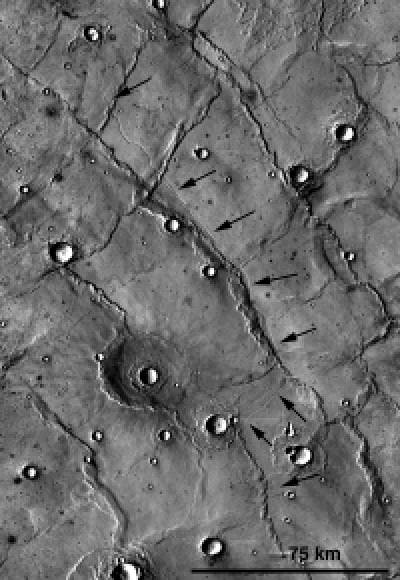When the first spacecraft flew by Mars in the 1960′s, the images returned revealed a relatively uninteresting-looking place, featureless in some areas and pockmarked with craters in most others. It looked a lot like the Moon. Later flybys and orbiting probes, however, gave us a closer look at other regions on the planet, providing a glimpse of what Mars is really like: a world of mountains, volcanoes, canyons, craters, old riverbeds and polar ice caps. It is little surprise then, that these striking geologic features captured scientists’ attention the most, and so areas like Hesperia Planum, a flat, relatively dull-looking plain, have received less attention over the years.
But there is a mystery in this region in the form of geologic features called rilles. No one has been able to figure out where they came from or how they formed.
The rilles in Herperia Planum are a series of about a dozen narrow, sinuous channels. They are up to a few hundred meters wide, and hundreds of kilometers long, but don’t appear to have any sources or destinations. The assumption has been that they were most likely created by lava flows, like their counterparts on the Moon. But apart from one very small volcano, there is little evidence of any volcanism in Hesperia Planum, which makes the appearance these rilles difficult to explain.
Another explanation could be water, but again, there are no obvious sources or other indications of past water in this region.
These enigmatic features have been the subject of study by scientists from the University at Buffalo, State University of New York. Geologist Tracy Gregg and her student Carolyn Roberts have been comparing them to rilles on the Moon, and their preliminary findings were presented today at the Annual Meeting of The Geological Society of America, in Minneapolis, and they hope to find some answers in further study and collaboration with other scientists.
“On the Moon we see these same kinds of features and we know that water couldn’t have formed them there,” Gregg said. “Everybody assumed these were huge lava flows, But if it turns out to be a lake deposit, it’s a very different picture of what Mars was doing at that time.”
So, were they formed by water, lava or something else? If it turned out to be water, that would of course be more interesting in terms of the search for possible habitable areas in Mars’ past.
Whichever explanation turns out to be correct, or even a different one, it will be one more piece of evidence which helps to further our understanding of this fascinating world, so much like our own in some ways, yet utterly alien in others
Source: Universe Today

No hay comentarios:
Publicar un comentario